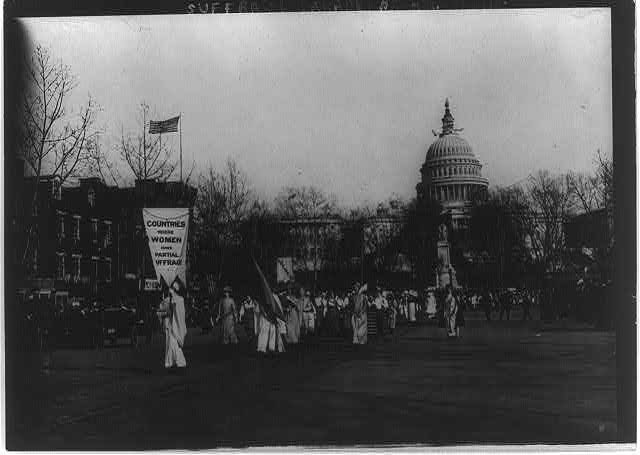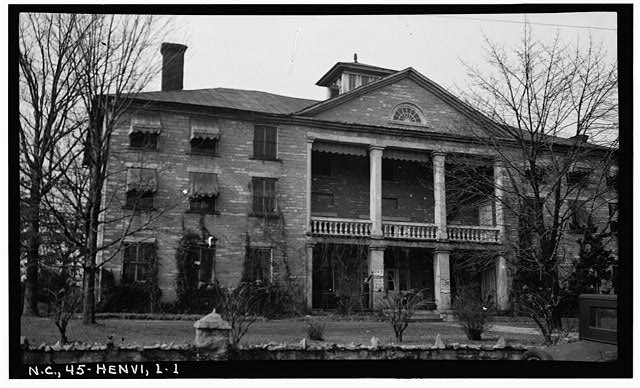Fashion for Women in the 1920's Pics/ Clip Art
Women in the 1920s in N Carolina
Related Entries: Women; Roaring Twenties; Gertrude Weil
"A New Woman Emerges"
by Louise Benner
Reprinted with permission from the Tar Heel Junior Historian. Spring 2004.
Tar Heel Junior Historian Clan, NC Museum of History
 A woman of 1920 would be surprised to know that she would exist remembered every bit a "new woman." Many changes would enter her life in the next 10 years. Significant changes for women took place in politics, the habitation, the workplace, and in education. Some were the results of laws passed, many resulted from newly developed technologies, and all had to do with changing attitudes toward the place of women in lodge.
A woman of 1920 would be surprised to know that she would exist remembered every bit a "new woman." Many changes would enter her life in the next 10 years. Significant changes for women took place in politics, the habitation, the workplace, and in education. Some were the results of laws passed, many resulted from newly developed technologies, and all had to do with changing attitudes toward the place of women in lodge.
The most far-reaching alter was political. Many women believed that it was their right and duty to have a serious part in politics. They recognized, too, that political decisions affected their daily lives. When passed in 1920, the Nineteenth Amendment gave women the right to vote. Surprisingly, some women didn't want the vote. A widespread attitude was that women's roles and men's roles did non overlap. This idea of "separate spheres" held that women should concern themselves with domicile, children, and organized religion, while men took care of business and politics. N Carolina opponents of woman suffrage, or voting, claimed that "women are not the equal of men mentally" and being able to vote "would accept them out of their proper sphere of life."
Though slow to employ their newly won voting rights, past the end of the decade, women were represented on local, state, and national political committees and were influencing the political agenda of the federal authorities. More emphasis began to be put on social improvement, such equally protective laws for child labor and prison house reform. Women active in politics in 1929 yet had lilliputian power, but they had begun the journey to actual political equality.
 With regard to education, North Carolina's female high schoolhouse students seldom expected to go to college. If they did, they usually attended a private college or Woman'due south College in Greensboro (now UNC-G), where in that location were no male students. Most of the Woman'southward College students became teachers or nurses, as these were considered suitable professions for women. North Carolina State College (now NCSU) enrolled its first woman student in 1921, simply it was not until 1926 that N.C. State decreed, "A woman who completes work for a degree offered by the institution [tin] be graduated." In 1928 merely twenty-one women were enrolled there.
With regard to education, North Carolina's female high schoolhouse students seldom expected to go to college. If they did, they usually attended a private college or Woman'due south College in Greensboro (now UNC-G), where in that location were no male students. Most of the Woman'southward College students became teachers or nurses, as these were considered suitable professions for women. North Carolina State College (now NCSU) enrolled its first woman student in 1921, simply it was not until 1926 that N.C. State decreed, "A woman who completes work for a degree offered by the institution [tin] be graduated." In 1928 merely twenty-one women were enrolled there.
The University of North Carolina opened housing to female graduate students in 1921, but they were non made welcome. The student newspaper headlined, "Women Not Wanted Hither." Few North Carolina women earned degrees during the 1920s. But times were changing, and each year more women earned higher degrees.
At the beginning of the decade, nearly Northward Carolina women lived in rural areas without electricity. Imagine trying to go along food fresh without a refrigerator, ironing (no drip-dry habiliment and so) with an fe that had to exist reheated constantly, cooking on a woodstove, going to an outside well for water, and e'er visiting an outhouse instead of a bathroom. Rural electrification did not reach many North Carolina homes until the 1940s.
 Urban women plant that electricity and plumbing made housework different, and often easier, with electrically run vacuum cleaners, irons, and washing machines. Electricity meant that people could stay upward later at night, because electric lights were more than efficient than kerosene lamps and candles. Indoor plumbing brought water inside and introduced a new room to clean—the bathroom.
Urban women plant that electricity and plumbing made housework different, and often easier, with electrically run vacuum cleaners, irons, and washing machines. Electricity meant that people could stay upward later at night, because electric lights were more than efficient than kerosene lamps and candles. Indoor plumbing brought water inside and introduced a new room to clean—the bathroom.
In the United States in the 1920s, only about xv percentage of white and thirty pct of black married women with wage-earning husbands held paying jobs. About Americans believed that women should non work outside the home if their husbands held jobs. Equally a outcome of this mental attitude, wives seldom worked at outside jobs. However, some married women in desperate demand took jobs in fabric mills.
Past 1922 North Carolina was a leading manufacturing state, and the mills were hiring female floor workers. Cotton fiber mills besides employed a few nurses, teachers, and social workers to staff social and educational programs. These mills did non rent black women, even so, considering of segregation. As a consequence, white millworkers oft hired black women every bit domestic and child-care workers. Fewer jobs were available in tobacco factories because most of their 1920s machinery was automated. The largest Northward Carolina tobacco manufacturers did employ both black and white women, merely strictly separated workers by race and gender.
At the same time, public acceptance of wage-earning jobs for young single women was growing. No longer being limited to piece of work every bit "mill girls" or domestics, these women began to perform clerical work in offices and retail work in shops and department stores. It became acceptable for working girls to live abroad from their families. Some young married women worked until they had children. Working for wages gave women independence, and by 1930 i in four women held a paying chore.
![Library of Congress. "Where there's smoke there's fire [192-?]."](https://www.ncpedia.org/sites/default/files/New%20to%20upload/FlapperLOC.jpg) Despite increasing opportunities in employment and education, and the expanding concept of a "woman's place," matrimony remained the goal of most young women. Magazine articles and movies encouraged women to believe that their economic security and social condition depended on a successful marriage. The bulk worked only until they married.
Despite increasing opportunities in employment and education, and the expanding concept of a "woman's place," matrimony remained the goal of most young women. Magazine articles and movies encouraged women to believe that their economic security and social condition depended on a successful marriage. The bulk worked only until they married.
Working women became consumers of popular products and fashions. Women who would never tolerate the strong smells and stains of chewing tobacco or cigars began to smoke the new, and relatively clean, mild cigarettes. Cigarettes were advertised to women as a sign of modern sophistication, and the 1920s "flapper" is normally pictured with a cigarette in her paw.
Today the hands recognized image of the flapper symbolizes the 1920s for many people. The flapper—with her curt skirts, short hair, noticeable makeup, and fun-loving attitude—represented a new freedom for women. The sometime restrictions on dress and behavior were being overthrown. Highly publicized flappers shortened their skirts, drank illegal alcohol, smoked, and otherwise defied order's expectations of proper comport for young women.
Is this glamorous and rebellious image of the flapper a true representation of the 1920s woman? Not entirely. In order to be a flapper, a woman had to have enough money and gratuitous time to play the part. Higher girls, unmarried girls living at home, and independent office workers most oftentimes presented themselves every bit flappers. However, the boilerplate woman did article of clothing the fashions fabricated pop past flappers. As often happens, unconventional wearable was gradually integrated into style and adopted at all income levels. Sears, Roebuck, and Company claimed that nine 1000000 families made purchases from its catalogs in 1925. The article of clothing sold through catalogs was based on high-fashion styles from Paris.
Flappers popularized slender, boyish fashions. Figures were flattened with undergarments. Hemlines, straight or uneven, gradually crept upward, and waistlines dropped. High-style evening vesture in tubular, sleeveless styles featured beading and fringe. Day dresses copied the evening lines, if not the trims. Short skirts were complemented past flesh-colored stockings worn with decorative shoes. Hair was cutting close to the head and covered outdoors by the close-fitting cloche hat. It became respectable to wearable makeup. Betwixt 1920 and 1930, women'south appearance changed completely.
Women found their lives changed in more than advent, nevertheless. Guild now accepted that women could exist independent and make choices for themselves in pedagogy, jobs, marital condition, and careers. Women'due south spheres had broadened to include public equally well as home life. The "new adult female" was on her way.
At the fourth dimension of this article'southward publication, Louise Benner worked as a curator of costume and textiles at the N Carolina Museum of History.
0 Response to "Fashion for Women in the 1920's Pics/ Clip Art"
Post a Comment